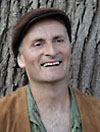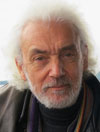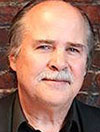Cutting-edge talks on green architecture brought to you by Brighton Permaculture Trust and Low Carbon Trust
Saturday 19 March 2016
10:30am to 5pm
Sallis Benney Theatre
University of Brighton
Grand Parade Building
Brighton BN2 0JY (Directions)
What is Green Architecture Day?
Green Architecture Day is an annual event Brighton Permaculture has run in partnership with Low Carbon Trust since 2002. Since then, the event has attracted over 2,000 participants to hear inspiring talks about how we can live and work in greener buildings. It has featured talks from speakers as varied as Ben Law, Christopher Day, Pooran Desai and Satish Kumar.
At Brighton Permaculture Trust, we believe that we need to give equal weight to sustainability in the built environment and regenerating our landscapes.
Who is Green Architecture Day for?
This event is open to anyone aged 16 or over and will be of interest to anyone interested in sustainability and buildings. The event has benefited students, home renovators, self builders, landlords, tenants, developers, builders, architects, engineers, planners and academics.
Read about Jonathan Davies’ experience at Green Architecture Day 2016 on his blog, studio treen.
2016 Programme
Find out more about the speakers.
Approaches to design
Duncan Baker-Brown, BBM Sustainable Design
Duncan opened Green Architecture Day 2016 with a talk about his latest research into reuse.
Resource-first design and our UK woodland resource
Ben Law, Ben-Law.co.uk
Ben spoke about his ‘resource first’ approach to designing buildings: starting with local materials, designing from what is available. He also focused on our woodland resource in the UK and how different management strategies can lead to a range of building materials. He featured his buildings and the growth of roundwood timber framing locally and globally.
Architecture as a social art
Nicolas Pople, NicolasPople.com
Nic talked about architecture inspired by nature and featured his recent church projects as well as small residential schemes.
Art, architecture and design
Alice Edgerley, Assemble
Alice talked about Assemble’s projects featuring community action and reuse, particularly the Granby Four Streets project in Liverpool, and the OTOProjects, a new workshop and performance space for the experimental music venue Café OTO in Dalston, Hackney.
Communities in transition
Nicola Lang, Transition Homes Community Land Trust
Nicola spoke about the challenge of achieving true sustainability: designing houses with a committee of passionate, principled people and the constraints placed on the design by the site, planning legislation, the local authority, costs, materials, the local community’s needs, our design principles, and all that on a limited budget. She featured their project for 27 terraced, timber frame and straw bale houses on a beautiful 7 acre site in Dartington, along with the country’s first community-level compost toilet scheme, renewable energy systems, food growing, as well as the integration of training and education opportunities.
Natural materials, high performance: Enjoying building together
Fran Bradshaw, Anne Thorne Architects
Fran spoke about designing and building a new thatched and straw bale low energy house with friends and family – a project full of pleasurable contradictions.
Beyond pattern languages: the work of Christopher Alexander
Michael Mehaffy, Sustasis Foundation
Michael joined us by Skype to talk about redefining architecture to work with natural processes, integrated with human settlements and ways of life. He featured examples of Christopher Alexander’s work as well as his own, illustrating the characteristics and qualities of an “architecture of life”.
Speaker Biographies
Duncan Baker-Brown
BBM Sustainable Design
 Duncan Baker Brown has been a director of award-winning architects BBM Sustainable Design since 1993. He also teaches and researches at the School of Architecture in Brighton. He has had the good fortune to work on some of the UK’s most high profile green developments such as the Greenwich Millennium Village, RIBA’s Futurehouse and The House That Kevin Built.
Duncan Baker Brown has been a director of award-winning architects BBM Sustainable Design since 1993. He also teaches and researches at the School of Architecture in Brighton. He has had the good fortune to work on some of the UK’s most high profile green developments such as the Greenwich Millennium Village, RIBA’s Futurehouse and The House That Kevin Built.
Ben Law
Ben-Law.co.uk
 Ben Law designs and builds using natural, local and sustainable materials. He trains apprentices in timber framing, woodland management and traditional crafts. Ben has been living within Prickly Nut Wood for twenty years. He is a woodsman and has integrated into this environment through immersion and observation. He has built several structures during this time, first with timber and canvas, then a yurt, and the famous Woodland House – the house that was the beginning of a new architectural vernacular.
Ben Law designs and builds using natural, local and sustainable materials. He trains apprentices in timber framing, woodland management and traditional crafts. Ben has been living within Prickly Nut Wood for twenty years. He is a woodsman and has integrated into this environment through immersion and observation. He has built several structures during this time, first with timber and canvas, then a yurt, and the famous Woodland House – the house that was the beginning of a new architectural vernacular.
Nicolas Pople
NicolasPople.com
 Nicolas Pople is an architect with his own practice in Sussex, a published author and lecturer at Southbank University School of Architecture in London. He specialises in sustainable design based on technologies that are part of a craft tradition, rather than industrialised processes. He believes that architecture’s role is to make us more human in our social relationships.
Nicolas Pople is an architect with his own practice in Sussex, a published author and lecturer at Southbank University School of Architecture in London. He specialises in sustainable design based on technologies that are part of a craft tradition, rather than industrialised processes. He believes that architecture’s role is to make us more human in our social relationships.
Alice Edgerley
Assemble, Video
 Alice works with Assemble, a collective based in London spanning the fields of art, architecture and design. They began working together in 2010 and are comprised of 15 members. Assemble seeks to address the typical disconnection between the public and the process by which places are made. Assemble champion a working practice is interdependent, seeking to actively involve the public as both participants and collaborators in the realisation of the work. They were the first collective to win the Turner Prize in 2015 for their interdisciplinary design approach.
Alice works with Assemble, a collective based in London spanning the fields of art, architecture and design. They began working together in 2010 and are comprised of 15 members. Assemble seeks to address the typical disconnection between the public and the process by which places are made. Assemble champion a working practice is interdependent, seeking to actively involve the public as both participants and collaborators in the realisation of the work. They were the first collective to win the Turner Prize in 2015 for their interdisciplinary design approach.
Nicola Lang
Transition Homes Community Land Trust
 Nicola started volunteering with Transition Homes in January 2014. She went on to become project coordinator, doing whatever needs doing to get the project off the ground – planning, liaising with consultants, raising funding, research, arranging consultation events as well as having an input through the design group. Her background isn’t in building though; she trained as a geochemist and climate change researcher. She pursued her interest in sustainable building by taking a straw bale building course at the Centre for Alternative Technology, and volunteering on builds around the UK and in Ireland. Her passion is for community-led solutions.
Nicola started volunteering with Transition Homes in January 2014. She went on to become project coordinator, doing whatever needs doing to get the project off the ground – planning, liaising with consultants, raising funding, research, arranging consultation events as well as having an input through the design group. Her background isn’t in building though; she trained as a geochemist and climate change researcher. She pursued her interest in sustainable building by taking a straw bale building course at the Centre for Alternative Technology, and volunteering on builds around the UK and in Ireland. Her passion is for community-led solutions.
Fran Bradshaw
Anne Thorne Architects, 15-40
 Fran is a partner at Anne Thorne Architects, a women-led firm exploring ideas through practice, participatory design, bringing together natural building materials with high tech components for beautiful building performance, sharing space through collective agreement, using post occupancy evaluation to feedback into briefing and complete the design circle, among other things. ATA is part of the 15-40 architecture collective, and Fran is deputy chair of the AECB (the Association for Environment Conscious Building).
Fran is a partner at Anne Thorne Architects, a women-led firm exploring ideas through practice, participatory design, bringing together natural building materials with high tech components for beautiful building performance, sharing space through collective agreement, using post occupancy evaluation to feedback into briefing and complete the design circle, among other things. ATA is part of the 15-40 architecture collective, and Fran is deputy chair of the AECB (the Association for Environment Conscious Building).
Michael Mehaffy
Sustasis Foundation
 Michael Mehaffy is a long-time colleague and former student of Christopher Alexander, the highly influential architect and author of A Pattern Language and The Nature of Order. Michael came to architecture in the 1970s after studying music and philosophy, and after forming a deep concern about the unsustainable nature of modern civilisation. He has held teaching or research appointments at six graduate institutions in five countries, and he is on the boards of two international journals of sustainable urban development, and three international NGOs dedicated to sustainable development. In recent years he has been working on the upcoming Habitat III conference and on implementation of the UN Sustainable Development Goals, as well as the COP21 Paris conference on climate change. View his presentation at the 2014 Urban Design Forum.
Michael Mehaffy is a long-time colleague and former student of Christopher Alexander, the highly influential architect and author of A Pattern Language and The Nature of Order. Michael came to architecture in the 1970s after studying music and philosophy, and after forming a deep concern about the unsustainable nature of modern civilisation. He has held teaching or research appointments at six graduate institutions in five countries, and he is on the boards of two international journals of sustainable urban development, and three international NGOs dedicated to sustainable development. In recent years he has been working on the upcoming Habitat III conference and on implementation of the UN Sustainable Development Goals, as well as the COP21 Paris conference on climate change. View his presentation at the 2014 Urban Design Forum.
Cat Fletcher
Freegle, Brighton Waste House
 Cat Fletcher is a waste activist who sources and matches up tonnes of unwanted goods and materials with people who can reuse them – preventing untold local waste. A founder of UK’s Freegle reuse network (2.3 million members), she also manages the Brighton Freegle group (27,000 local members). She is currently the only reuse manager for a UK local authority and is ensuring that Brighton and Hove reuse resources wherever possible through innovative, collaborative and creative projects like the City Reuse Depot.
Cat Fletcher is a waste activist who sources and matches up tonnes of unwanted goods and materials with people who can reuse them – preventing untold local waste. A founder of UK’s Freegle reuse network (2.3 million members), she also manages the Brighton Freegle group (27,000 local members). She is currently the only reuse manager for a UK local authority and is ensuring that Brighton and Hove reuse resources wherever possible through innovative, collaborative and creative projects like the City Reuse Depot.
At Green Architecture Day, Cat ran tours of Brighton Waste House, which is very close to our venue, in the morning and at lunch time on Green Architecture Day. Cat was part of the design team and sourced most of the materials for award-winning building.
Waste House Tours and Stalls
Included in Green Architecture Day 2016 was the opportunity to visit the award-winning Waste House, as well as stalls from Brighton Permaculture Trust and Permanent Publications.
